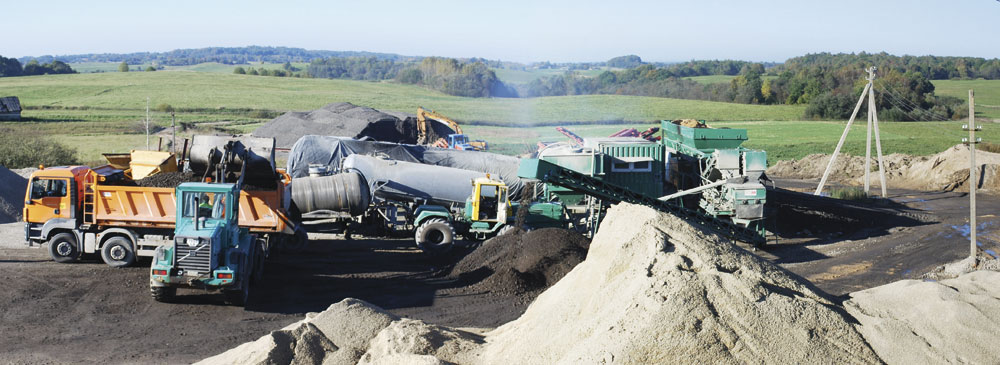Achieving Good Grades

Bitumen expert calls for care in the recycling of asphalt
Everything to do with asphalt recycling requires thought and effort to do it properly; but recycling asphalt is absolutely the right thing to do. This was the message that Nynas UK technical manager Dr Ian Lancaster delivered to the Institute of Quarrying’s annual conference in October last year. Asphalt is 100% recyclable, he said, but he cautioned that care is required to ensure the successful reuse of bituminous materials.
Dr Lancaster was presenting his paper ‘Binder grade correction and rejuvenation’. There is a popular conception that ‘waste from bituminous materials does not exist’, and it is true that recent years have seen a significant increase in the reuse and recycling of asphalt, he said. ‘There is also a fundamental change in the way that recycled asphalt is treated with regard to its influence in the new asphalt mixture as a whole.’
Early approaches to recycling considered recycled asphalt pavement (RAP) as ‘black aggregate’ in which the binder made little or no contribution to the properties or volume of any new asphalt mixture to which it was added. ‘This is not strictly true,’ Dr Lancaster said. ‘The fact is that you have two bitumen grades in the mixture, the binder around the RAP and the fresh bitumen; and both play a part.’
While the physical properties, such as penetration and softening point, of the fresh bitumen and its volumetric content will be known, those of the RAP binder will not be. Both these fundamentals – the blend and content – of the recycled component must be calculated so that its overall influence on the asphalt mix can be determined. Then, ‘correction’ to the RAP binder’s grade can be made to meet the mix’s design requirements and also attention paid to its volumetric contribution.
‘It is a distinct move from empirical to a more mechanistic design. And the process is not as easy as it looks.’ The penetration of the bitumen in the RAP will depend on its age, original asphalt type (open, dense; surface, binder course etc) and geographical location. Dr Lancaster made the point that – empirically – this binder will generally be expected to follow the normal blending rules for bitumen, making ‘correction for grade’ a relatively simple process in principle.
Dr Lancaster’s paper then explored the practical applications of blending principles applicable to asphalt recycling, providing worked examples of binder corrections. One demonstrative example showed that RAP with a binder penetration of 15 could be corrected to 100/150-pen bitumen by blending with 190-pen bitumen in the ratio 17% RAP binder to 83%. Production of a 40/60-pen binder would require correction in a 50:50 ratio. So far, so simple.
However, when the binder volumetric content of the RAP and that of the asphalt mixture are taken into consideration, the calculation becomes significantly more difficult – ‘there is a lot of maths behind it,’ Dr Lancaster said – and considerable care is needed in the application of blending principles. Working out the total affect of RAP binder on an asphalt mix containing recycled material involves an element of ‘back calculation’ to get exactly the right match of bitumen volumes to meet the required asphalt end result. ‘The volumetric contribution of the binder in the RAP is difficult to deal with.’
Certain ‘natural’ laws apply; for instance, in some situations it is relatively easier to design harder mixes. ‘There are drivers for recycling to make use of all bitumen grades and to use as much RAP as you possibly can, which – pushed to the extreme – could have you searching for 800-pen bitumen, which isn’t going to happen,’ said Dr Lancaster.
Earlier in his presentation Dr Lancaster had dealt with rejuvenation of bitumen in RAP – getting it back to its virgin state – as a prelude to talking about binder grade correction. To consider the practicalities of rejuvenation, he said, it is necessary to understand the ageing processes to which the binder in an asphalt mix is subjected. These can include the effects of oxygen, water, infrared and ultraviolet radiation, thermal stresses and mechanical and chemical attrition. A lot can happen to a binder during its in-service life.
As a result of these ageing processes, bitumen gets harder, stiffer and more brittle; its penetration goes down and its softening point up. Underpinning this are chemical actions taking place which impact on bitumen’s four principal components: saturates, resins, aromatics and asphaltenes. The end result can be fundamental chemical, physical and rheological changes in the binder. The question to ask, said Dr Lancaster, is ‘are these changes irreversible? Can the clock be put back and ageing reversed?’
It is relatively easy to correct the penetration and softening point of bitumen around RAP – this can be done by adding ‘snake oil’ or other such substances. But this does not take into account molecular changes. ‘If you conduct a rheological profile of ‘young’ 125-pen bitumen, age it and by so doing take it down to 15 pen, then add oil to bring it back to its former grade, a second rheological profile at this stage will be different to the first. You will find no equivalence. The young and the old 125-pen bitumens are not the same.’
To fully return a RAP bitumen to grade while restoring its chemical balance and reversing chemical oxidation is theoretically possible but a tough proposition. ‘Rejuvenation is very difficult,’ said Dr Lancaster. It is perhaps more pragmatic to accept that while rejuvenation is possible, it is not actually feasible. At this point Dr Lancaster moved on to binder grade correction, after which he returned, briefly, to rejuvenation.
‘It would be great if you could fully restore RAP bitumen back to its virgin state because then you wouldn’t have to bother with binder correction. The doors would also be open to using very high quantities of RAP in a normal mix – surely the holy grail of asphalt recycling.’
